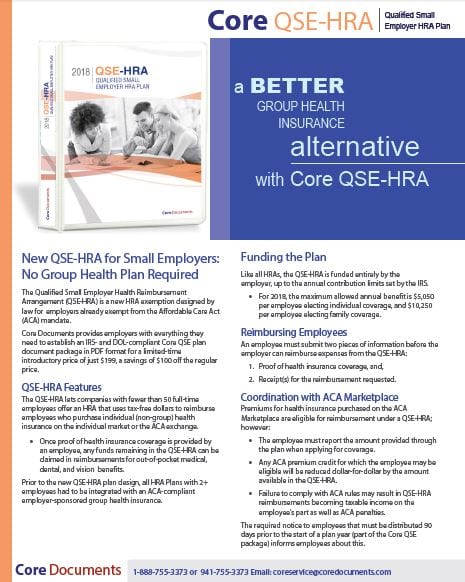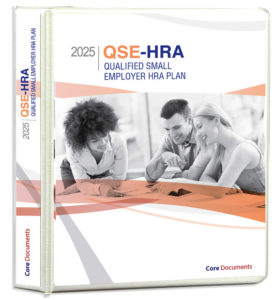Home / Blog / What is proof of MEC for QSE-HRA eligibility?
What is proof of MEC for QSE-HRA eligibility?
The 21st Century Cures Act of 2016 (Cures Act) allows an eligible employer with fewer than 50 employees to provide a Qualified Small Employer Health Reimbursement Arrangement (QSE-HRA) to eligible employees. While a QSE-HRA does not permit the employer to offer a qualifying employer-sponsored group health plan, it does require the employee to have a health plan with minimum essential coverage (MEC) and provide proof of MEC before the employer can reimburse him or her for qualifying medical expenses. Employers must know what qualifies as proof of MEC for QSE-HRA reimbursements.

The IRS requires proof of MEC for QSE-HRA eligibility before any reimbursement is made to an employee. Proof of MEC is also needed for any dependent for whom a claim is made.
Initial Proof of MEC for QSE-HRA
Click here to use our Employee Attestation for Initial Proof of MEC form.
To establish participation eligibility or for the first request for reimbursement in a plan year, the employee must submit what the IRS calls “initial” proof of MEC. The following meet the initial proof requirement:
- An insurance card, explanation of benefits, or other proof of coverage for the employee and any dependents eligible under the QSE-HRA
along with
- The employee’s signed attestation that the coverage is MEC
OR
- An attestation by the employee stating the employee and dependent(s) are covered by MEC with the name of the company providing the coverage and the date coverage began (see form link, above).
IRS Notice 2017-67 says, “An eligible employer may rely on the employee’s attestation unless the employer has actual knowledge that the individual whose expense is submitted does not have MEC.”
Attestation for Reimbursements
Click here to use our Attestation for Reimbursement of an Incurred Expense form.
Separate attestation is required at every reimbursement. This attestation affirms that the employee (and dependent, if applicable) continue to be insured with a MEC health plan. The per-reimbursement attestation may be on a separate form or included in the claim form itself (see example, above).
From IRS Notice 2017-67, pp. 28-29:
Question 43: May a QSEHRA reimburse an eligible employee on a taxable basis if the employee fails to provide proof of MEC for the individual for whom the employee seeks payments or reimbursements?
Answer 43: No.
Types of MEC
Click here to download the Types of Minimum Essential Coverage (QSE-HRA) document.
From IRS Notice 2017-67, Qualified Small Employer Health Reimbursement Arrangements, Part III — Administrative, Procedural, and Miscellaneous, p. 57, Appendix A:
“Minimum essential coverage means health care coverage under any of the following programs. It does not, however, include coverage consisting solely of excepted benefits. Excepted benefits include stand-alone vision and dental plans, workers’ compensation coverage, and coverage limited to a specified disease or illness.”
Types of Minimum Essential Coverage (QSE-HRA)
Employer-sponsored coverage:
- Group health insurance coverage for employees under:
– A plan or coverage offered in the small or large group market within a state,
– A plan provided by a governmental employer, such as the Federal Employees Health Benefit program, or
– A grandfathered health plan offered in a group
- A self-insured health plan for employees,
- COBRA coverage,
- Retiree coverage, or
- Coverage under an expatriate health plan for employees and related
Individual health coverage:
- Health insurance purchased directly from an insurance company,
- Health insurance purchased through the Marketplace,
- Health insurance provided through a student health plan,
- Catastrophic coverage, or
- Coverage under an expatriate health plan for non-employees such as students and
Coverage under government-sponsored programs:
- Medicare Part A coverage,
- Medicare Advantage plans,
- Most Medicaid coverage,*
- Children’s Health Insurance Program (CHIP) coverage,
- Most types of TRICARE coverage,
- Comprehensive health care programs offered by the Department of Veterans Affairs,
- Health coverage provided to Peace Corps volunteers,
- Department of Defense Nonappropriated Fund Health Benefits Program,
- Refugee Medical Assistance, or
- Coverage through a Basic Health Program (BHP) standard health plan.
Other coverage:
- Certain foreign coverage,
- Certain coverage for business owners, or
- Coverage recognized by HHS as minimum essential **
*Medicaid programs that provide limited benefits generally don’t qualify as minimum essential coverage.
**Plans recognized as minimum essential coverage are listed at: www.cms.gov/CCIIO/Programs-and- Initiatives/Health-Insurance-Market-Reforms/minimum-essential-coverage.html, scroll down and click on the link for the list of approved plans.
Related articles:
QSE-HRA reimbursement to employees without health insurance
How to Report QSE-HRA Employee Benefits on 2017 Form W-2
When is an employer eligible for a QSE-HRA?
QSE-HRA: Small Employer HRA Plan Documents Just $199
Video: QSE-HRA — The Stand-Alone HRA Returns!
04:00 Minute Executive Summary:
PDF Brochure –Core QSE-HRA Qualified Small Employer HRA Plan Document (with forms)


QSEHRA Plan Document Package

Our friendly and knowledgeable staff is available to
answer any questions you may have via e-mail or phone call,
Monday through Friday, 9 am to 5 pm ET:
1-888-755-3373
No annual fee — Core Documents does not require an annual renewal fee to maintain your plan document package. A plan document only needs to be updated when there are changes in the plan or in the law that make it necessary. We will notify you when there are sufficient changes in the Code to require amending and restating your Plan and ask that you keep us informed when there is a change to your plan. You can amend and update your plan document anytime, at a discounted fee and only when necessary, which is the most cost-effective way to maintain it.
*Fast Service — Most orders placed by 3 PM are returned via email the same day, Monday through Friday. Weekend orders are sent out Monday morning. Plan document packages are processed in the order received. During our busiest months (December, January, and February), the rush order fee (see order form) marks your document to be processed immediately.
Refund Policy: Goods and services provided by Core Documents, Inc. are non-refundable upon receipt. Orders cancelled prior to shipping are subject to a fee to cover the cost of goods and services provided during the review, draft, and preparation of your order.
The Trusted Source of Affordable Benefit Plan Documents for over 27 Years.
Core Documents is the country’s leading provider of cost-effective, tax-saving benefit plan documents for Section 125 Cafeteria plans and Health Reimbursement Arrangements. The Trusted Source since 1997, thousands of satisfied agents and employer groups nationwide rely upon Core Documents for free plan design consulting services, plan document updates, ERISA Wrap SPDs, and administration services.